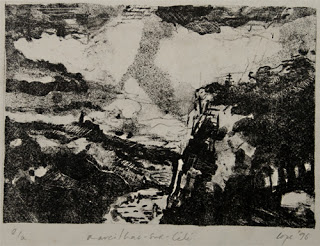First Posting of Two Posts
part two, second post – Leonardo dea Vinci’s drawings of rocks
15 x 10 cm
Stone Lithography
© The Artist.
Edition sold out.
My Personal Experience of an Artist’ s Residency
In 1996, I won an artist-in-residency to make limited editions of stone lithographs at a print-making studio. Basically, this association has it’s aims to promote stone lithography & encourage artistic talent. So it chose six artists and invited them for a month long stay & make editions of stone lithography. It was a great experience. A residency (or a painting workshop) should make you work in a different & fresh way. Open one’s ‘artist-self’ up to learning. Re- envigorating. Creating in a new context, with the pleasure of meeting new people. I certainly meet some wonderful people … great technicians too 🙂
I did some printmaking at Bristol Printmakers Workshop. Printmaking is my second medium after painting. It was my second subject for my BA hons in 1987. I later taught it for two years at Adult Ed…. though it has now been nine years since I last had a ‘printmaking campaign’. I can feel it calling again. Besides my computer, I have an old copper plate that I care for very much.
32 x 25 cm
Ink, papier Moulin Larroque
© The Artist.
email for price etc.
Marcilhac sur Célé for an artists residency
Marcilhac sur Célé is a wild crazy type of place at the bottom of a three metre limestone cliff. Limestone rock & chaos. It was winter time. It was crazy. Wild landscape. Prehistoric. Staring at rocks & cliffs… same type of problem that I was grappling with last week in the painting Grand Roc, Les Eyzies, Dordogne. Without making any claims to be a geologist, except to say that drawing & painting rocks & cliffs faces makes you stare at them for hours on end… sometimes I imagine maybe sheep sheperds & prehistoric shamans did this also. Certainly fascinating to chat to speleologues & palentologists about earth formations.
Ink, papier Moulin Larroque
© The Artist.
how to draw rocks & cliffs?
INK
© The Artist.
The chalk in the Célé Valley (lot) is more stratfied & ‘crazed’ than the Vézère Valley (Les Eyzies is in the Dordogne), where it seems more compact, older(?). The Céle has more ‘blow holes’ or ‘trous du soufflure’ where air was trapped in the sedimentation process but the Vézère has more erosion from the river over the ages. Both are incredible places.I wanted these drawings to be as precise as possibile so you could use them as rock-climbing maps. Only find & keep those ‘anchor’ points!! Hold on to them as this isn’t an easy subject. Doesn’t conform to clasical landscape painting. Has many suprises….and are easily dismissed by those who do not know what cliff faces really look like.
1996
28 x 38 cm
ink, papier Moulin Larroque
© The Artist.
A VENDRE
1996
ink & gouache, papier Moulin Larroque
© The Artist.
A VENDRE
In the next posting, I’ll photograph the other editions & drawings, there’s a whole stack of them










